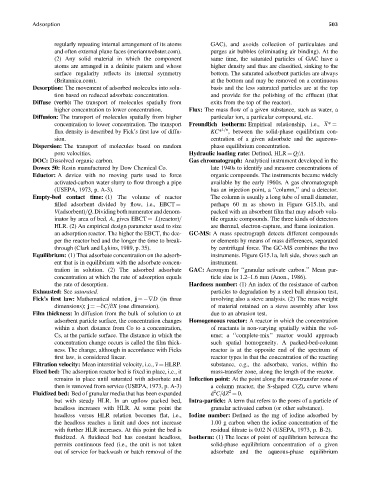Page 548 - Fundamentals of Water Treatment Unit Processes : Physical, Chemical, and Biological
P. 548
Adsorption 503
regularly repeating internal arrangement of its atoms GAC), and avoids collection of particulates and
and often external plane faces (meriamwebster.com). purges air bubbles (eliminating air binding). At the
(2) Any solid material in which the component same time, the saturated particles of GAC have a
atoms are arranged in a definite pattern and whose higher density and thus are classified, sinking to the
surface regularity reflects its internal symmetry bottom. The saturated adsorbent particles are always
(Britannica.com). at the bottom and may be removed on a continuous
Desorption: The movement of adsorbed molecules into solu- basis and the less saturated particles are at the top
tion based on reduced adsorbate concentration. and provide for the polishing of the effluent (that
Diffuse (verb): The transport of molecules spatially from exits from the top of the reactor).
higher concentration to lower concentration. Flux: The mass flow of a given substance, such as water, a
Diffusion: The transport of molecules spatially from higher particular ion, a particular compound, etc.
concentration to lower concentration. The transport Freundlich isotherm: Empirical relationship, i.e., X* ¼
flux density is described by Fick’s first law of diffu- KC* 1=n , between the solid-phase equilibrium con-
sion. centration of a given adsorbate and the aqueous-
Dispersion: The transport of molecules based on random phase equilibrium concentration.
pore velocities. Hydraulic loading rate: Defined, HLR ¼ Q=A.
DOC: Dissolved organic carbon. Gas chromatograph: Analytical instrument developed in the
Dowex 50: Resin manufactured by Dow Chemical Co. late 1940s to identify and measure concentrations of
Eductor: A device with no moving parts used to force organic compounds. The instruments became widely
activated-carbon water slurry to flow through a pipe available by the early 1960s. A gas chromatograph
(USEPA, 1973, p. A-3). has an injection point, a ‘‘column,’’ and a detector.
Empty-bed contact time: (1) The volume of reactor The column is usually a long tube of small diameter,
perhaps 60 m as shown in Figure G15.1b, and
filled adsorbent divided by flow, i.e., EBCT ¼
V(adsorbent)=Q.Dividingbothnumeratoranddenom- packed with an absorbent film that may adsorb vola-
inator by area of bed, A, gives EBCT ¼ L(reactor)= tile organic compounds. The three kinds of detectors
HLR. (2) An empirical design parameter used to size are thermal, electron-capture, and flame ionization.
an adsorption reactor. The higher the EBCT, the dee- GC-MS: A mass spectrograph detects different compounds
per the reactor bed and the longer the time to break- or elements by means of mass differences, separated
through (Clark and Lykins, 1989, p. 35). by centrifugal force. The GC-MS combines the two
Equilibrium: (1) That adsorbate concentration on the adsorb- instruments. Figure G15.1a, left side, shows such an
ent that is in equilibrium with the adsorbate concen- instrument.
tration in solution. (2) The adsorbed adsorbate GAC: Acronym for ‘‘granular activate carbon.’’ Mean par-
concentration at which the rate of adsorption equals ticle size is 1.2–1.6 mm (Anon., 1986).
the rate of desorption. Hardness number: (1) An index of the resistance of carbon
Exhausted: See saturated. particles to degradation by a steel ball abrasion test,
Fick’s first law: Mathematical relation, j ¼ rD (in three involving also a sieve analysis. (2) The mass weight
dimensions); j ¼ qC=qX (one dimension). of material retained on a sieve assembly after loss
Film thickness: In diffusion from the bulk of solution to an due to an abrasion test.
adsorbent particle surface, the concentration changes Homogeneous reactor: A reactor in which the concentration
within a short distance from Co to a concentration, of reactants is non-varying spatially within the vol-
Cs, at the particle surface. The distance in which the ume; a ‘‘complete-mix’’ reactor would approach
concentration change occurs is called the film thick- such spatial homogeneity. A packed-bed-column
ness. The change, although in accordance with Ficks reactor is at the opposite end of the spectrum of
first law, is considered linear. reactor types in that the concentration of the reacting
Filtration velocity: Mean interstitial velocity, i.e., v ¼ HLRP. substance, e.g., the adsorbate, varies, within the
Fixed bed: The adsorption reactor bed is fixed in place, i.e., it mass-transfer zone, along the length of the reactor.
remains in place until saturated with adsorbate and Inflection point: At the point along the mass-transfer zone of
then is removed from service (USEPA, 1973, p. A-3) a column reactor, the S-shaped C(Z) t curve where
2
2
Fluidized bed: Bed of granular media that has been expanded d C=dZ ¼ 0.
but with steady HLR. In an upflow packed bed, Intra-particle: A term that refers to the pores of a particle of
headloss increases with HLR. At some point the granular activated carbon (or other substance).
headloss versus HLR relation becomes flat, i.e., Iodine number: Defined as the mg of iodine adsorbed by
the headloss reaches a limit and does not increase 1.00 g carbon when the iodine concentration of the
with further HLR increases. At this point the bed is residual filtrate is 0.02 N (USEPA, 1973, p. B-2).
fluidized. A fluidized bed has constant headloss, Isotherm: (1) The locus of point of equilibrium between the
permits continuous feed (i.e., the unit is not taken solid-phase equilibrium concentration of a given
out of service for backwash or batch removal of the adsorbate and the aqueous-phase equilibrium

